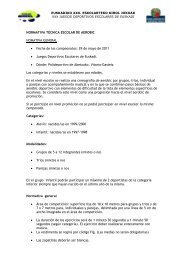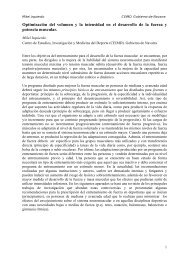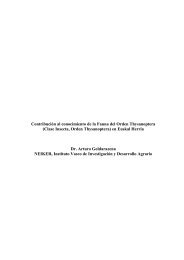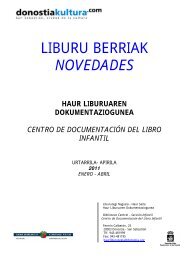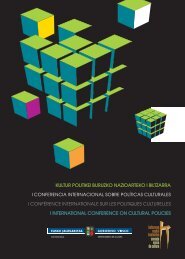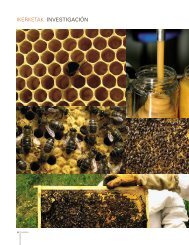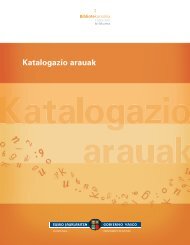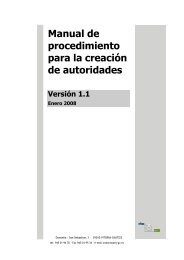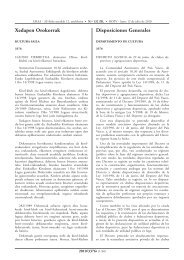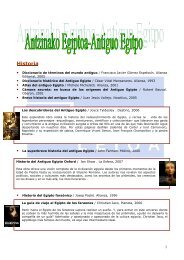The Basque Country (pdf, 4,3Mb) - Kultura Saila - Euskadi.net
The Basque Country (pdf, 4,3Mb) - Kultura Saila - Euskadi.net
The Basque Country (pdf, 4,3Mb) - Kultura Saila - Euskadi.net
Create successful ePaper yourself
Turn your PDF publications into a flip-book with our unique Google optimized e-Paper software.
7.4. Digital culture and multimedia<br />
Digitization is a widespread phenomenon involving technological<br />
change associated with information (storage, transmission,<br />
decoding and use). It is a reflection of changes in social habits<br />
and economic model. Although a great deal of effort has been<br />
put into technology and equipment in <strong>Euskadi</strong>, there is a lot yet<br />
to be done in terms of digital content and art. <strong>The</strong>re are three<br />
levels of digitization in the strictly cultural arena: digitizing our<br />
heritage to ensure its preservation and access; digitizing cultural<br />
contents to further their progress; and digitizing creation and<br />
artistic expression (multimedia, art <strong>net</strong>...).<br />
In the first level of digitization of our cultural heritage, all of<br />
our public institutions are making significant efforts toward<br />
digitization: the creation of a digital library, as well as archives<br />
and daily press (www.euskadi.<strong>net</strong>/liburutegidigitala). <strong>The</strong>re are<br />
also a number of initiatives in progress (<strong>Basque</strong> Parliament,<br />
provincial councils, Eresbil, EITB, Susa, Euskaltzaindia, <strong>Euskadi</strong>ko<br />
Filmategia...) as well as organisations that specialise in this activity:<br />
Euskomedia, Elhuyar, Vicomtech, Gaia partner companies, etc.<br />
At the second level, use and development, digital cultural contents<br />
are becoming increasingly more common in cultural production<br />
and dissemination, both in Euskara (a “eus” Inter<strong>net</strong> domain<br />
would be very useful) and Spanish. This is key to avoiding cultural<br />
cloning and also for generating markets in the medium term.<br />
<strong>The</strong> third level, specific creative activity, together with the<br />
creators of digital art or communication (electronic art, <strong>net</strong> art,<br />
etc.), includes multimedia.<br />
As it is still a burgeoning field, today the market itself cannot serve<br />
as the driving force behind cultural multimedia. This means that<br />
public initiative is necessary – in the area of education, language<br />
policy, recreating multimedia material on our cultural heritage –<br />
as well as actions aimed at market creation.<br />
7.5. Traditional crafts<br />
Midway between handicrafts, art and memory, <strong>Basque</strong> traditional<br />
craft-making for the most part is linked to the creation of<br />
agricultural and herding products.<br />
For their activities, shepherds built wooden utensils: makila<br />
(shepherdʼs staff), uztaiak (collars for livestock), aska (containers<br />
for food) or kaiku (containers for making cheese). But progress in<br />
general, and the evolution of agriculture in particular, led some<br />
artisans to specialise<br />
in manufacturing objects for other people in exchange for goods<br />
or money.<br />
Artisans made farming implements out of wood and iron (carts,<br />
ploughs, hoes...), wooden utensils (kutxas, tables...). With leather<br />
they made such things as shoes (abarka), wineskins and leather<br />
balls. Other crafts included baskets, hooks, <strong>net</strong>s and rigs, pottery<br />
– which advanced significantly with the arrival of the potterʼs<br />
wheel – items made of fabric (espadrilles), musical instruments<br />
(xirulak, txistuak, dulzainas, txalapartak, tambourines…), and<br />
all types of objects related to the decorative arts (jewellery,<br />
decorative metalwork, restoration…).<br />
Today <strong>Basque</strong> traditional crafts includes all types of materials<br />
(stone, clay, wood, paper...) for both decorative pieces and practical<br />
objects, and the field has opened itself up to new designs. New<br />
artisans are coming on the scene (miniaturists, model makers,<br />
surfboard makers…), using new materials for new uses.<br />
Craft enterprises tend to be small and heterogeneous microcompanies.<br />
<strong>The</strong> number (including self-employed workers) is estimated at around<br />
300, of which 261 (115 in Gipuzkoa, 113 in Bizkaia and 33 in Araba)<br />
are registered, generating about 500-600 jobs.<br />
<strong>The</strong> main activities include the manufacture of wooden furniture<br />
(13.4%), wooden objects (12.9%), pottery (12.6%), items made of<br />
vegetable fibres (9.4%), textiles (7.9%), jewellery (6.9%), metal<br />
(6.5%), glass (6.1%), leather (4.7%), marble, stone and plaster<br />
(1.1%), musical instruments (1.1%) and others (17.3%).<br />
<strong>The</strong> profile of artisans today is quite different from what might<br />
be expected: there are more men (65%) than women; the level of<br />
education is higher than other in sectors; they strive to perfect<br />
their professional activity (37% have taken advanced courses) and<br />
to innovate their work tools; they have computers (for information,<br />
management and improving designs); the vast majority is over<br />
35; a third does not live on craftmaking alone; and most sales<br />
direct between artisans and clients.<br />
<strong>The</strong> future of the crafts industry is uncertain, mainly owing to<br />
competition with industrially made products and imports from<br />
developing countries. Moreover, there are not enough young<br />
people to take over for the older generation, and it is difficult to<br />
achieve acceptable levels of profitability.<br />
Any major turnaround would call for a more effective regulatory<br />
scheme, institutional support for artisans, implementing a quality<br />
label system (certificate of quality), improving old marketing<br />
channels and opening new ones, and linking traditional crafts to<br />
local culture and tourism.<br />
61<br />
euskadi.<strong>net</strong> home page, website of<br />
<strong>Basque</strong> Government resources.<br />
Craftsman making a <strong>Basque</strong> pelota<br />
basket.



